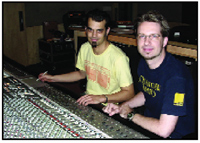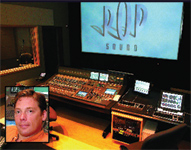Over the past decade, multichannel audio has gone from a novel idea to an industry standard in a bevy of entertainment mediums that include feature films, broadcast television and videogames. These days, it seems as if almost every request that comes into an audio post production house starts with surround sound specifications and then works backwards. The one exception to this rule, according to houses working in the market, is in the independent feature film industry where budgets often preclude a complete 5.1 mix, leaving audio pros to come up with clever, almost-there workarounds.

Luminous Sound's (L-R) Tre Nagella and Chris Bell: The studio recently completed sound design and mix duties on a theatrical spot for Radio Shack.
|
There's no doubt that audio pros have been biding their time before multichannel television broadcasts become the norm rather than the exception. While they've watched mandates and deadlines pass without action, it looks as if 2006 will finally be the year where broadcasts will begin.
The proof, according to POP Sound's creative/technical director Steve Thompson comes from the networks that are providing his facility with specs for their 5.1 delivery requirements. "Even though that sounds like old news, actually getting a piece of paper from Fox or NBC that says, 'Here's how we want it delivered. Here's how we want our metadata [means a lot]."
So what else is happening in the world of 5.1 surround? Read on...
RAPID GROWTH FOR EPISODIC TV

POP's Steve Thompson on 5.1 for broadcast TV: "The infrastructure now exists to carry the soundtracks all the way through to the home."
|
Of course, no discussion of 5.1 would be complete without a word from the folks at Dolby (www.dolby.com/), one of the companies that provide multichannel technologies. According to Rocky Graham, manager, digital television applications at Dolby, the past year has been very encouraging to the company. "Really, starting with last season, there has been a very rapid growth in the area of episodic television being broadcast in Dolby Digital 5.1," he says. "Prior to that there had been, over the last few years, growth in the area of sports in particular and special events, and that's really extended now into the prime-time episodic world."
Last season, he adds, a couple of networks broadcast their entire scripting programming schedule in HD with Dolby Digital 5.1. This year it will be even more. "I think we'll have three networks with virtually all of their scripted HD programming in 5.1. In addition, the other networks will be having several other programs [in HD and 5.1] as well. There is also an increase in the cable network world for films and original programming on premium movie networks. They've been doing that for awhile, but every year there is more of that," he says. Consumers are literally buying into the idea of 5.1 by purchasing surround sound systems for homes, and Graham sees competition among broadcasters to offer 5.1 to viewers. "There is a competitive aspect to it. Getting the first broadcaster on the air in 5.1 was a lot more difficult than getting the last couple," he reports. "Once one gets going and attracts some attention, everyone else wants to get in on it."
REMAINING FLEXIBLE
The team at Bethlehem, PA-based Star City (www.starcityrecording.com/) are versed in many aspects of 5.1 post production, including SACD projects for Sony, films such as Loggerheads, Rounding First and The Final Patient, as well as work on Jam Sessions, a show airing on the BET Jazz Network.

Dolby's Rocky Graham: "Starting with last season, there has been a very rapid growth in the area of episodic television being broadcast in Dolby Digital 5.1."
|
Carl Cadden-James, VP of production and engineering, feels that 5.1 is a broad market. "It's not about broadcast or film. It's not exclusive to that," he says. "We've done a lot of surround mixing, and I'm personally sold on it. I think once you've had an opportunity to sit down and listen to a well-recorded, well-mixed and carefully-contemplated mix in 5.1, that stereo mixes pale in comparison. But, I just don't know that people at home are setting up surround systems in a fashion that gives them the same satisfaction that I get from a controlled acoustic environment."
Cadden-James adds that for a facility like Star City, it has been important to be active on a number of 5.1 fronts. "We have to do everything we can do. Maybe we're a little unique because the person that heads this operation is a producer [Jeff Glixman] who gets a fair amount of work on his own, but we turn nothing away," he says.
Star City's Studio A, which is a room they've used for a variety of products, is outfitted with an SSL 9000 console and a Steward microperf drop-down screen with a Sony projector. "We exercise Sony nine-pin control over a Beta deck or a Digi Beta deck and we sit there and roll back and forth," Cadden-James explains. "If we don't have to look at the big picture, a lot of times we just roll a QuickTime movie into Pro Tools, and as soon as we mix a song and we want to see what the net affect is, we drop back into machine control, grab the deck, roll away and look at it."

Surrounded by togas and battlestars
|
That type of room, he explains, gives Star City the ability to be flexible while accepting assignments. "The fact that we have a really great music room allows us to do music for records and the type of surround work that we've done. I would think that studios would benefit from being able to do both, especially a surround facility," he says. "I guess it depends on your market, how you're positioned and how long you've been around. We're an hour outside of New York City, and that puts us a little far [away]. We have to embrace multiple business models for success."
COMBINING AUDIO, VIDEO SERVICES
When New York-based Digital Arts (www.digital-arts.net/) moved into its new location two years ago, the plan was to set up a top-to-bottom audio and video finishing house. "We had the client base and we wanted to serve them with a package deal," explains CEO/creative director Axel Ericson. "We believe it's better to bring everything under one roof. It also seemed that people were slow moving on the high def side of things and we decided to move aggressively. We focused on high def packages, and that enabled us to start tackling the feature film world." Most recently the company has been working closely with VOOM, one of the premier HDTV outlets in New York, providing post services on promos and other material. In addition to high def finishing and 5.1 audio work, Digital Arts does digital intermediates.

Star City's surround room houses an SSL 9000 console and Quested 412 soffitted monitors.
|
For audio assignments, the company's engineers use Digidesign Pro Tools, which Ericson is happy with now thanks to the increased number of busses available. Previous versions, he explains, ran out of busses so quickly that it was difficult for them to work on movie projects. "That is no longer the case with the new Pro Tools, and that has enabled us to tackle the various markets pretty seriously," he says. "We're now going after that market because we can offer the entire audio and video post package, digital intermediates, 5.1 surround mix and we can package them together now."
One thing that Ericson finds interesting is that there is a pioneering spirit in audio again. "It's like you had in the old audio days where you had to build your own aesthetic. There aren't many 5.1 plug-ins if you use Pro Tools, and we found that very often we like building our own to create interesting sounds and sound textures in," he says. "So, I'm very curious to see which manufacturers are going to address that as real plug-in packages. The ones that are out there are fairly traditional at the moment, and I think there's a lot to be done on that end."
IN THEATER SPOTS
Luminous Sound (www.luminoussound.com/) in Dallas has done any number of projects in the 5.1 world. Most recently the company handled the music, sound design and mix duties on a theatrical spot for Radio Shack and its in-house production company Circle R Media. "It was for a remote-control toy car, but the commercial was more like a movie, so we had to add a lot of sound effects and a lot of stuff wasn't in there," explains producer/engineer/mixer Chris Bell. "It came to us basically stripped down with nothing in it."
Luminous creative director Tre Nagella and CEO/owner Paul Loomis composed the music for the spot. "We tried to add a bunch of special treatments to the music as far as effects and stuff like that to take advantage of the capabilities of 5.1," Nagella says. "We approached the composition of the music pretty straight forward, like we would most other compositions, but we did a lot with the sound design, the effects and Foley. We were able to use the capability of the 5.1 sound field to have movement for things that happen on screen from speaker to speaker."
In addition to the music beds, Nagella reports that they treated the vocals differently. "They didn't want it to be a straight forward vocal, they wanted it to be effected, filtered," he says. "So, there was a lot of vocal panning from speaker to speaker. It was really fast paced video, so it lent itself to that kind of atmosphere of 5.1, where things are moving from speaker to speaker, back and forth."
The mix, he adds, was done on ProControl with a Pro Tools|HD system.
A HISTORY OF 5.1
POP Sound (www.popstudios.com/) in Santa Monica has been a player in the 5.1 market for years, starting out in the early '90s by transferring and mixing feature films for broadcast and DVDs. Most recently, the company has been mixing commercials for theatrical release. "We have a long history of 5.1," says the POP sound creative/technical director Steve Thompson. "It's kind of old hat for us, and all of our rooms have been built from the ground up as 5.1 rooms."
Things have changed over the last year, says Thompson. "Over the last year or so [there has been] a push from our clients to do 5.1 for broadcast television now that digital television and HDTV is beginning to reach the point of maturity. The infrastructure now exists to carry the soundtracks all the way through to the home. That's been a long time coming."
POP made the capital investment years ago, outfitting each of their 11 rooms with all digital audio equipment. Currently, POP uses AMS Neve consoles coupled with Pro Tools|HD.
The big investment, Thompson says, has been in video equipment. "D-5 decks have largely been the de facto standard of choice for HD masters, which requires 5.1 layback and things like that," he says. "We've had the Dolby E equipment, which is what a lot of the networks are requiring for their delivery, but now HDCAM-SR is becoming more popular - that's become our latest investment in the last few months, both for the post theatrical world as well as the commercial broadcast world."
Video equipment, Thompson admits, has been harder to stay on top of in terms of knowledge, but it's been important to their business. "We do quite a bit of layback work because we can support those video formats," he says. "Of course, we like to do the mix here, but we do a reasonable amount of layback work from things coming from elsewhere because we can support those formats."
5.1 TRICKS FOR THE INDIES
It's a slam dunk that major studio feature films get the surround sound treatment, but that is not so for many of the independent films that Audio Post & Picture (www.audiopostpicture.com/) in Los Angles works on. David Ho, the company's president, explains that indie films will go for the 5.1 treatment for DVD release but not much more. "If they go theatrical or festivals it's usually LTRT," he says.
Recent films that have come through the Audio Post & Picture door include Primer, Blue Car and Dark Heart. While Ho won't push the expense of 5.1 on producers, he will at least recommend LTRT for its stereo compatibility and its similarity to surround in a theater. "Sometimes people do just ask for stereo or sometimes the elements don't dictate having a surround mix, so it really just depends on the project. If you have the elements to do it then we'll do a surround mix," he says. "If they come in with very little to work with then we'll just do stereo."
One of the realities of working in 5.1 is that often budgets run out by the time the process gets to audio post production. "They want to get as much as they can, of course, but a lot of times they don't have enough money to pay for a mix fully," he explains. "So, we've found some corners that we cut so that we can get a 5.1 experience without spending an inordinate amount of time panning everything here and there. We've got some tricks that we do that can get them a fuller sound more quickly."
As an example, Ho points out that at least he will put a stereo background out of the elements into the mix via Pro Tools. "If they don't have it we'll try to cut something in quick, just to give it that stereo feel. We throw something in the back just so it's a fuller experience.
"Then, typically I'll throw music into the subwoofer so it makes it seem like it's a fatter mix," he says. "Things you would do normally, but we make sure we get them done when they are on a budget. The thing that takes time is when there's lots of individual elements that they want panned all over the place. For independent films you don't run into that too much, because you're not doing action movies."
Back to Top